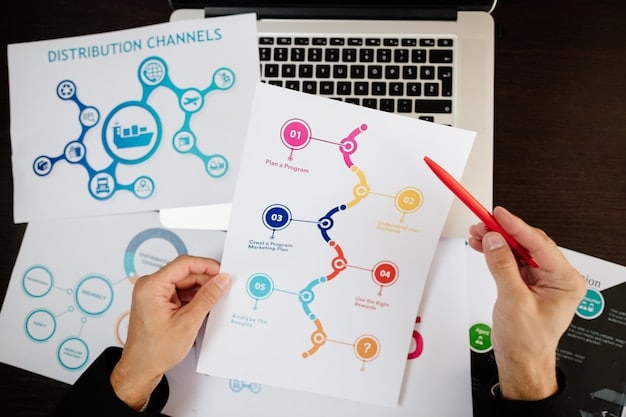Unlock Hidden Revenue: Reactivate US Accounts for a 5% Sales Boost

Unlock Hidden Revenue: How to Reactivate Dormant US Accounts and Achieve a 5% Sales Uplift in 6 Months details proven strategies to re-engage inactive customers, offering a step-by-step guide to revitalize your sales pipeline and drive a significant revenue increase within a defined timeframe.
Is your sales team leaving money on the table? Many US businesses overlook a goldmine: their dormant accounts. This guide, Unlock Hidden Revenue: How to Reactivate Dormant US Accounts and Achieve a 5% Sales Uplift in 6 Months, provides actionable strategies to reignite those relationships and boost your bottom line.
Understanding the Value of Dormant US Accounts
Dormant accounts, often perceived as lost causes, represent a significant untapped revenue stream. These are customers who have previously engaged with your business but have since become inactive. Understanding their potential value is the first step in unlocking hidden revenue.
Why focus on reactivating dormant accounts instead of solely pursuing new leads? The answer lies in cost-effectiveness and higher conversion rates. Customers who have already interacted with your brand are more likely to convert than cold prospects. They are familiar with your products or services and have, at some point, recognized their value.
The Cost-Effectiveness of Reactivation
Acquiring a new customer is significantly more expensive than retaining or reactivating an existing one. Marketing efforts, sales cycles, and onboarding processes all contribute to the higher cost. Reactivating a dormant account bypasses many of these upfront expenses, allowing you to allocate resources more efficiently.
Higher Conversion Rates
Dormant accounts have a higher propensity to convert because they already possess a level of trust and familiarity with your brand. They understand your value proposition and have previously found your offerings relevant to their needs. A well-crafted reactivation campaign can reignite their interest and remind them of the benefits you provide.

Ignoring your dormant accounts is like leaving money on the table. By understanding their potential value and implementing targeted reactivation strategies, you can significantly boost your sales and achieve sustainable growth.
Identifying and Segmenting Dormant Accounts
Not all dormant accounts are created equal. To effectively reactivate them, you need to identify them accurately and segment them based on their characteristics and previous interactions. This allows you to tailor your approach and maximize your chances of success.
Defining dormancy is crucial. How long does a customer need to be inactive before they are considered dormant? This timeframe will vary depending on your industry, business model, and customer lifecycle. Analyze your data to determine the optimal threshold for your specific context.
- Recency: When was the customer’s last interaction with your business?
- Frequency: How often did the customer engage with your business before becoming dormant?
- Monetary Value: How much revenue did the customer generate for your business?
- Engagement: Did the customer open emails, click on links, or visit your website?
Segmenting your dormant accounts based on these factors allows you to create targeted campaigns that resonate with their specific needs and motivations. For example, a high-value customer who recently became dormant might require a different approach than a low-value customer who has been inactive for years.
Effective segmentation empowers you to personalize your messaging, offers, and communication channels. This increases the relevance of your reactivation efforts and significantly improves your chances of re-engaging these valuable customers.
Crafting a Compelling Reactivation Campaign
A well-crafted reactivation campaign is essential for re-engaging dormant accounts. It should be personalized, targeted, and offer a compelling reason for customers to return to your business. Generic, impersonal campaigns are unlikely to yield significant results.
Start by understanding why the customer became dormant in the first place. Did they have a negative experience? Did their needs change? Did they simply forget about your business? Gathering this information will help you tailor your messaging and address their specific concerns.
Personalized Messaging
Generic emails are easily ignored. Personalize your messaging by addressing the customer by name, referencing their past purchases or interactions, and acknowledging their inactivity. Show them that you value their business and understand their individual needs.
Incentives and Offers
Offer a compelling incentive to encourage customers to return. This could be a discount, a free gift, exclusive access to new products or services, or a special promotion. Make the offer time-sensitive to create a sense of urgency.
Multi-Channel Communication
Don’t rely solely on email. Reach out to customers through multiple channels, such as social media, phone calls, or even direct mail. This increases the likelihood of them seeing your message and engaging with your brand.
By crafting a compelling reactivation campaign that is personalized, targeted, and offers a valuable incentive, you can significantly increase your chances of re-engaging dormant accounts and driving a 5% sales uplift.
Leveraging Data and Analytics for Optimization
Data and analytics are crucial for optimizing your reactivation efforts. By tracking key metrics and analyzing the results of your campaigns, you can identify what works and what doesn’t, and make adjustments to improve your performance.
Implement tracking mechanisms to monitor the effectiveness of your reactivation campaigns. Track open rates, click-through rates, conversion rates, and revenue generated. This data will provide valuable insights into the performance of your campaigns and help you identify areas for improvement.
- A/B Testing: Experiment with different messaging, offers, and communication channels to see what resonates best with your dormant accounts.
- Segmentation Analysis: Analyze the performance of different segments to identify which groups are most responsive to reactivation efforts.
- Campaign Tracking: Monitor the results of your campaigns and make adjustments as needed to improve your performance.
By leveraging data and analytics, you can continuously refine your reactivation strategies and maximize your ROI. This data-driven approach ensures that your efforts are targeted, efficient, and effective.

Optimizing your reactivation efforts with data and analytics is an ongoing process. Continuously monitor your results, experiment with new approaches, and adapt your strategies to stay ahead of the curve and achieve your sales goals.
Overcoming Common Challenges in Reactivation
Reactivating dormant accounts is not without its challenges. You may encounter issues such as outdated contact information, negative customer experiences, or a lack of budget and resources. Addressing these challenges proactively is essential for success.
One of the most common challenges is outdated contact information. Customers may have changed their email addresses, phone numbers, or mailing addresses since their last interaction with your business. Implementing a data cleansing process can help ensure that your contact information is accurate and up-to-date.
Addressing Negative Experiences
Some customers may have become dormant due to a negative experience with your business. Addressing these concerns directly and offering a sincere apology can go a long way in repairing the relationship and regaining their trust.
Securing Budget and Resources
Reactivation campaigns often require a dedicated budget and resources. Make a compelling case to your management team by highlighting the potential ROI of reactivating dormant accounts and demonstrating the value of investing in these efforts.
Despite these challenges, reactivating dormant accounts remains a highly effective strategy for boosting sales and driving revenue growth. By proactively addressing these challenges and implementing best practices, you can maximize your chances of success.
Measuring Success and Sustaining Momentum
Measuring the success of your reactivation efforts is crucial for determining whether you are achieving your goals and sustaining momentum. Track key metrics and analyze the results of your campaigns to assess their impact and identify areas for improvement.
Define clear and measurable goals for your reactivation campaigns. These goals should be aligned with your overall sales objectives and provide a benchmark for measuring your success. Examples of key metrics to track include:
- Reactivation Rate: The percentage of dormant accounts that are successfully reactivated.
- Conversion Rate: The percentage of reactivated accounts that make a purchase.
- Revenue Generated: The total revenue generated from reactivated accounts.
Regularly review these metrics and compare them to your goals. If you are not meeting your targets, identify the reasons why and make adjustments to your strategies. Celebrate your successes and use them to motivate your team and sustain momentum.
Sustaining momentum requires ongoing effort and commitment. Continuously monitor your results, experiment with new approaches, and adapt your strategies to stay ahead of the curve and ensure long-term success.
| Key Element | Brief Description |
|---|---|
| 🔑 Identify Dormancy | Define the timeframe for a customer to be considered inactive. |
| 📊 Segment Accounts | Categorize dormant accounts based on recency, frequency, and monetary value. |
| 📧 Craft Campaigns | Personalize messaging and offer compelling incentives. |
| 📈 Analyze & Optimize | Track metrics to refine strategies and maximize ROI. |
FAQ – Frequently Asked Questions
▼
Dormancy is defined by a period of inactivity that varies by industry. Analyze customer behavior to determine how long a customer can be inactive before being labeled dormant.
▼
Discounts, exclusive offers, and free gifts often motivate. The best incentive is relevant to the customer’s past purchases and addresses their specific needs.
▼
Personalization is crucial. Generic emails are ignored. Tailor your messaging to resonate with each customer’s individual history and preferences.
▼
Address their concerns directly. A sincere apology and a tailored solution can rebuild trust and encourage them to return.
▼
Track metrics like reactivation rate, conversion rate, and revenue generated. These insights reveal the strategy’s impact on your bottom line and guide further optimization.
Conclusion
Reactivating dormant US accounts is a proven strategy for boosting sales and achieving a 5% sales uplift within six months. By understanding the value of these accounts, implementing targeted campaigns, and leveraging data and analytics, businesses can unlock hidden revenue and drive sustainable growth.





